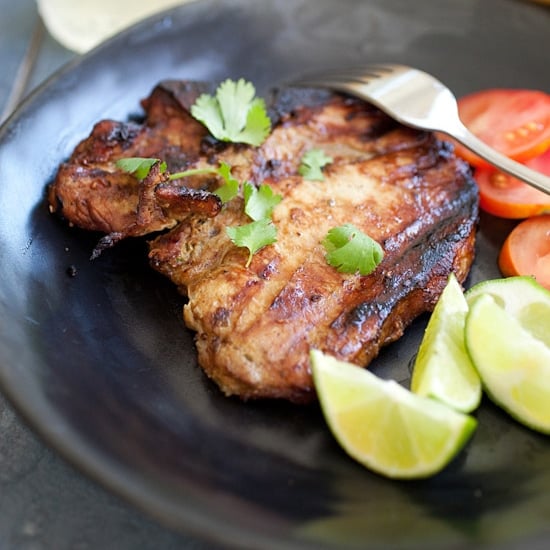This post may contain affiliate links. Please read my privacy policy.
Shrimp sinigang (sinigang na hipon) is a comforting soup with big prawns and fresh veggies swimming in a savory, sweet, and sour tamarind broth. Enjoy with steamed white rice for a classic Filipino meal!
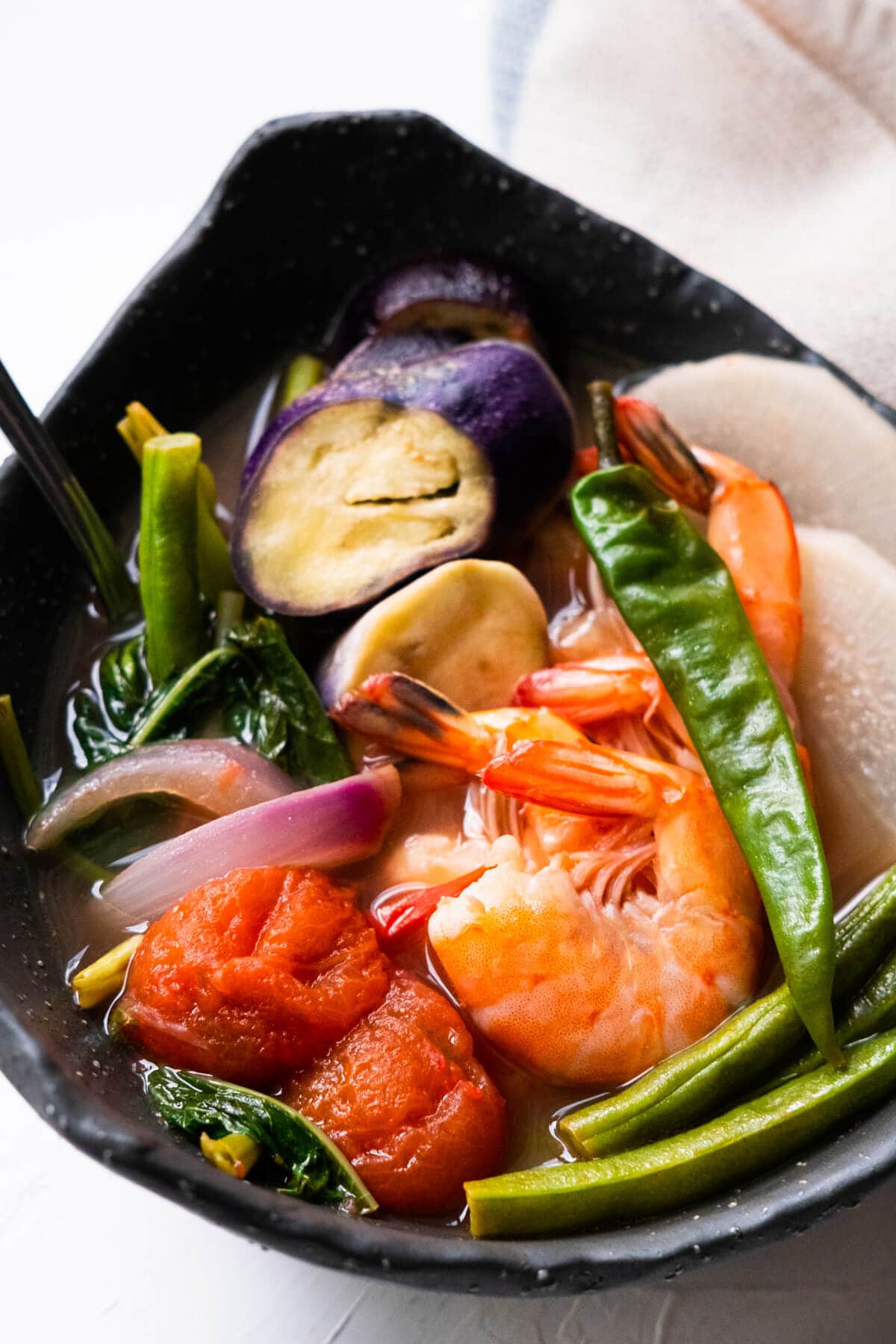
Filipino Sinigang
Sinigang Filipino soup is considered one of the best soups in the world, and I totally agree! The sourness of the soup comes from fruits abundant in the Philippines such as tamarind, guava, green mangoes, and bilimbi (kamias).
In fact, the late Doreen Fernandez, one of the most respected food writers in the Philippines, once argued that sinigang should be considered the national dish of the Philippines rather than adobo.
It is traditionally served with steamed white rice. But if you want to keep it light, this shrimp sinigang recipe is satisfying on its own. It’s really healthy too, so feel free to go for another bowl or two!
Other iconic Filipino dishes you need to try are Lumpia and Pancit!
What Is Shrimp Sinigang
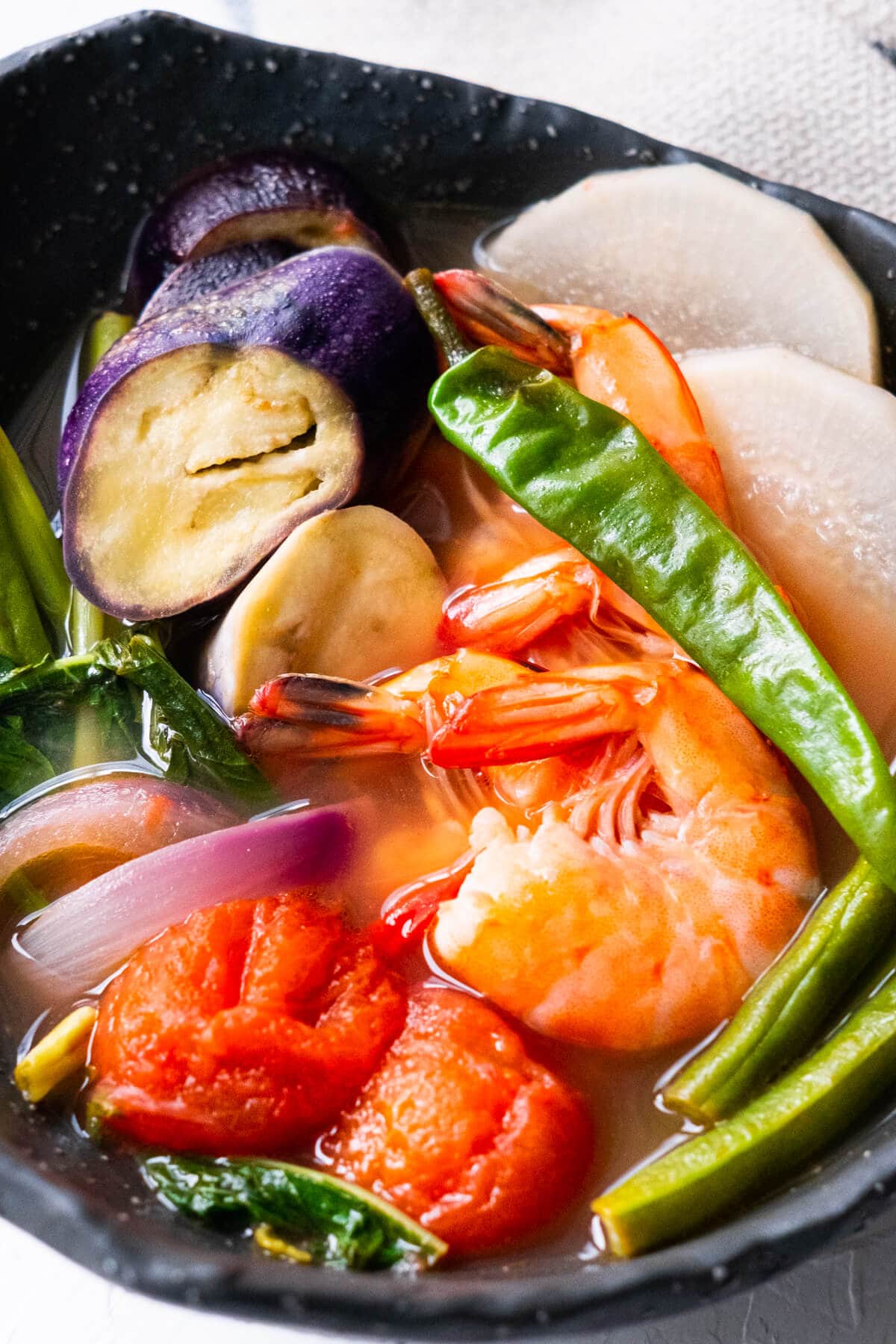
Shrimp sinigang is one of the most popular versions of the beloved Filipino dish sinigang. It comes from the Tagalog word “sigang,” meaning “to stew,” but it’s nothing like the typical thick and heavy stews you might be familiar with.
Filipino sinigang recipes always include protein, usually pork or seafood, and a variety of vegetables, all cooked in an amazing sour broth. The sourness typically comes from tamarind, a tropical fruit that gives sinigang its signature tang.
Main Ingredients For Sinigang Recipe
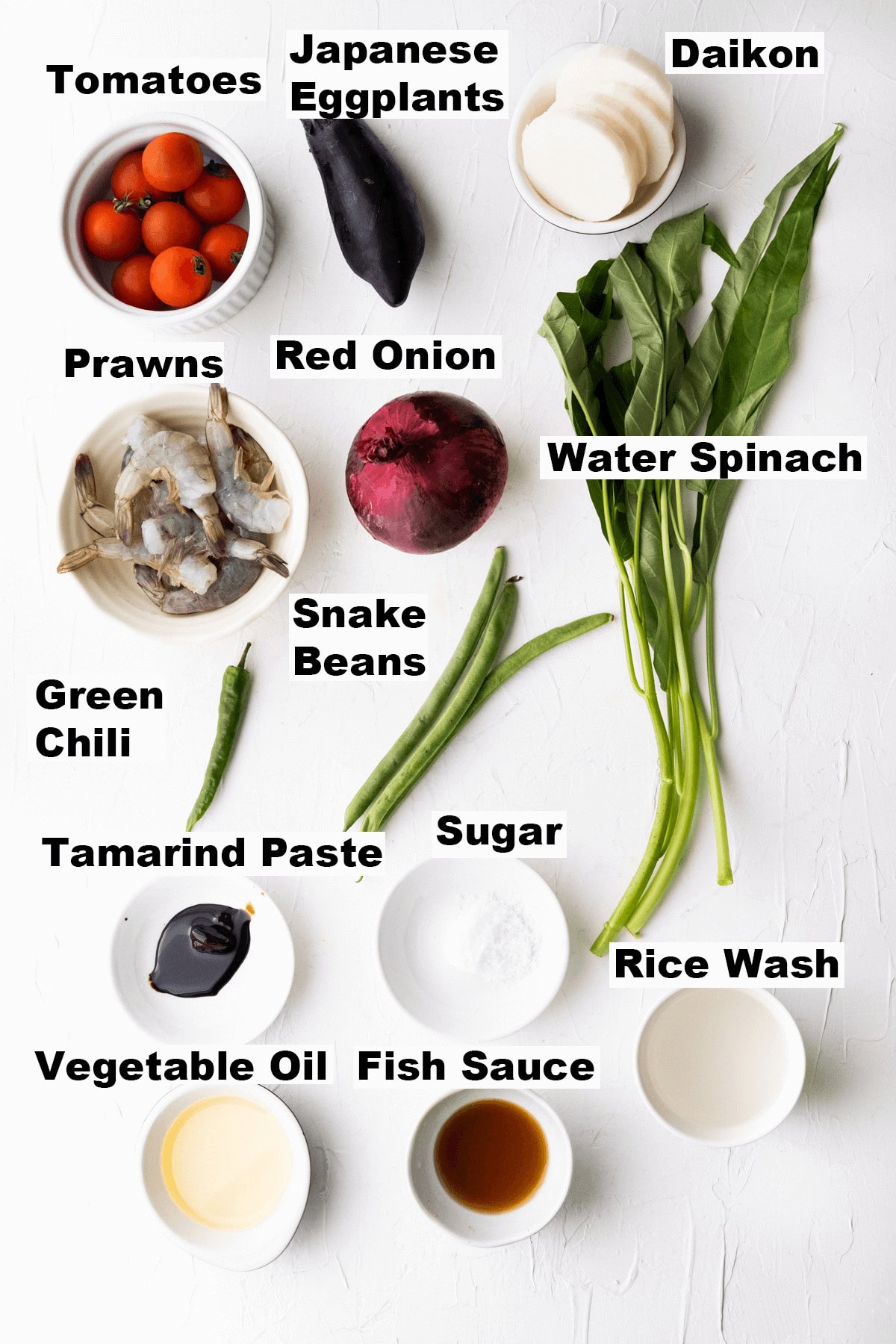
- Shrimp – I love using big prawns for this sinigang recipe because they become so tender and juicy in the broth. But you can also use smaller shrimp, peeled or unpeeled, depending on your preference.
- Tamarind paste – A concentrated version of tamarind pulp (sampalok in Filipino). Tamarind is a tropical fruit that gives sinigang its signature sourness. You can also use it for Pad Thai and other tamarind-based dishes!
- Rice wash – In the Philippines, sinigang is usually served with a bowl of steamed rice. Rice wash is the starchy water leftover from rinsing the grains, and it adds body to the sinigang soup.
- Fish sauce – This fermented fish extract adds a salty, umami flavor that balances the sourness of the tamarind.
- Tomatoes and onions – These veggies form the flavor base of our shrimp sinigang sa sampalok recipe.
- Green chili – I like using finger chilis (siling haba or pangsigang) for their mild heat that doesn’t overpower all the other flavors.
- Assorted vegetables – Snake beans, daikon (white radish), eggplant, and water spinach (kangkong or morning glory) are classic sinigang ingredients.
See the recipe card for full information on ingredients.
Recipe Variations
- Pork or beef sinigang: Swap out the shrimp for pork (sinigang na baboy) or beef (sinigang na baka). For pork, use cuts like belly or shoulder, while beef shank or short ribs are great options for a beef sinigang.
- Seafood sinigang: Try adding mild-tasting seafood like white fish fillets and squid. You can also completely replace the shrimp with salmon, tuna, red snapper, and other types of fish.
- Veggie substitutes: Bok choy, spinach, mustard greens, and even kale will work as shrimp sinigang vegetables.
- Shrimp sinigang with gabi: Add chunks of gabi (aka taro root) for a thicker, heartier broth.
- Souring agents: Aside from tamarind, you can use other sour ingredients like guava, kamias (a sour berry), and even green mangoes.
How To Make Shrimp Sinigang
This sinigang na hipon recipe is so quick and easy to make for such a flavorful soup. And it’s all about timing! Once you get the broth started, add your ingredients in stages so everything cooks perfectly. Always add the shrimp last so they don’t overcook and get rubbery!
Here’s how to make this shrimp sinigang recipe from scratch:
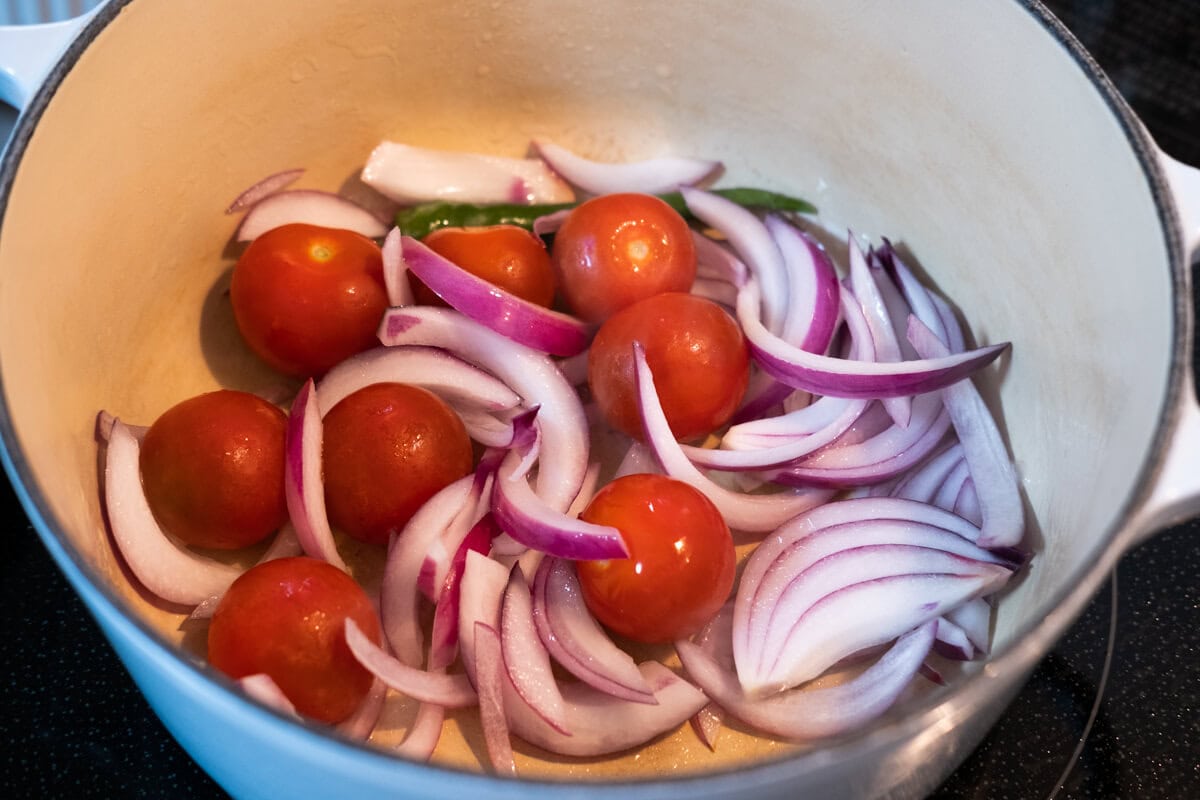
Step 1. Heat the vegetable oil in a deep pot and sauté the red onion, tomatoes and green chili for two to three minutes.
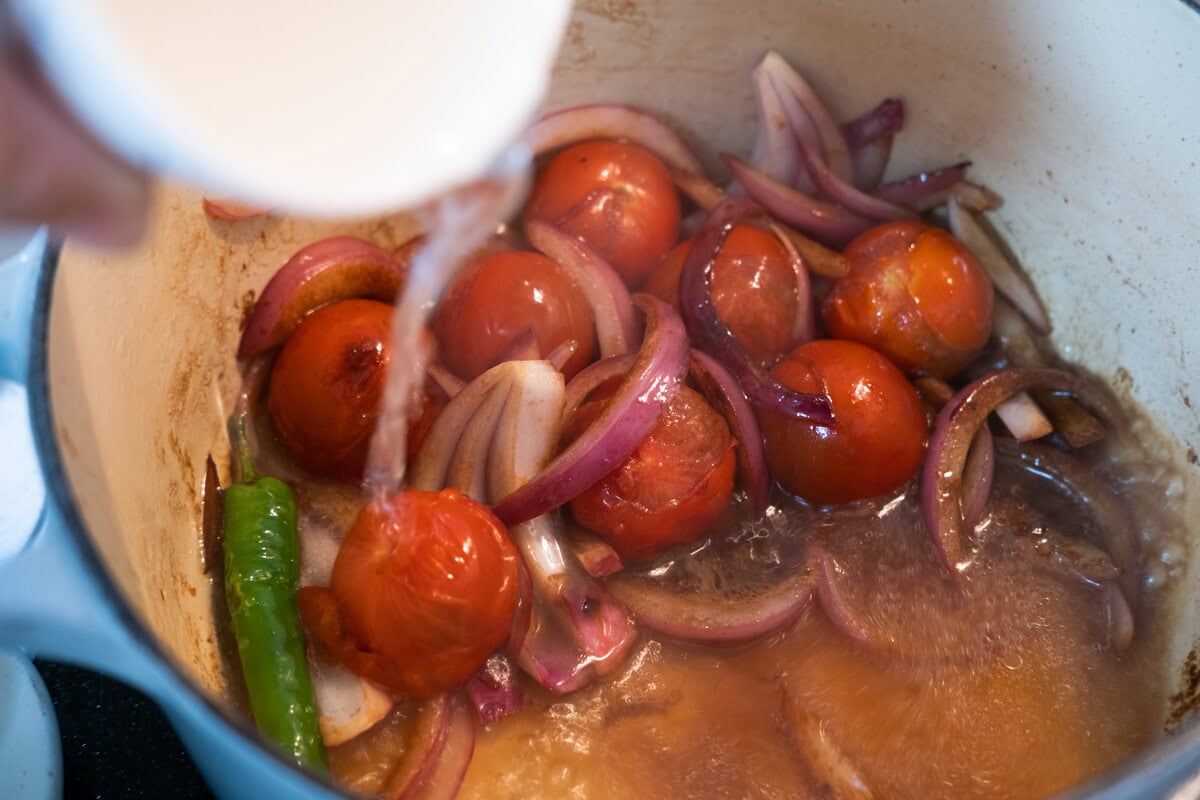
Step 2. Add tamarind paste and the rice wash to the pot. Bring this to a boil and then turn down to a simmer to cook the vegetables.
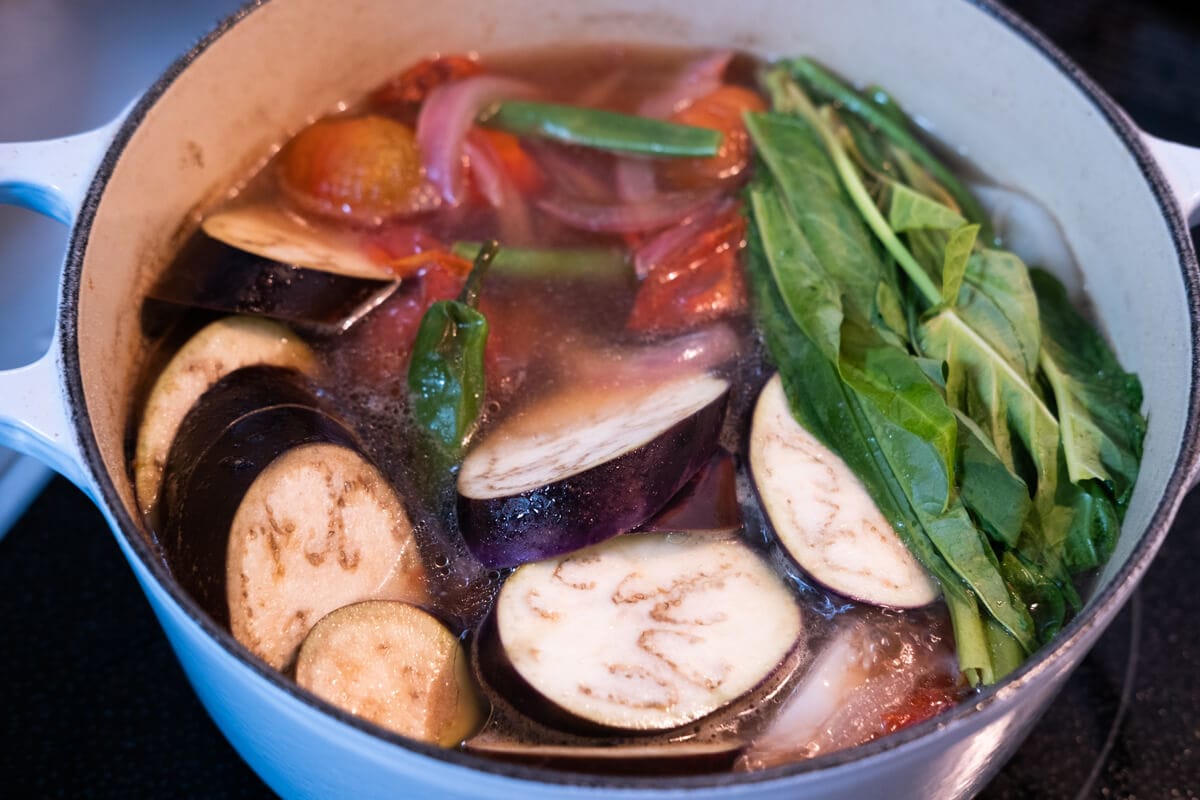
Step 3. Add them to the pot according to how long they take to cook. Add the vegetables that take longer to cook first. As an estimate, the snake beans will take around 7 minutes, the daikon and eggplant around 5 minutes and the water spinach around 3 minutes.
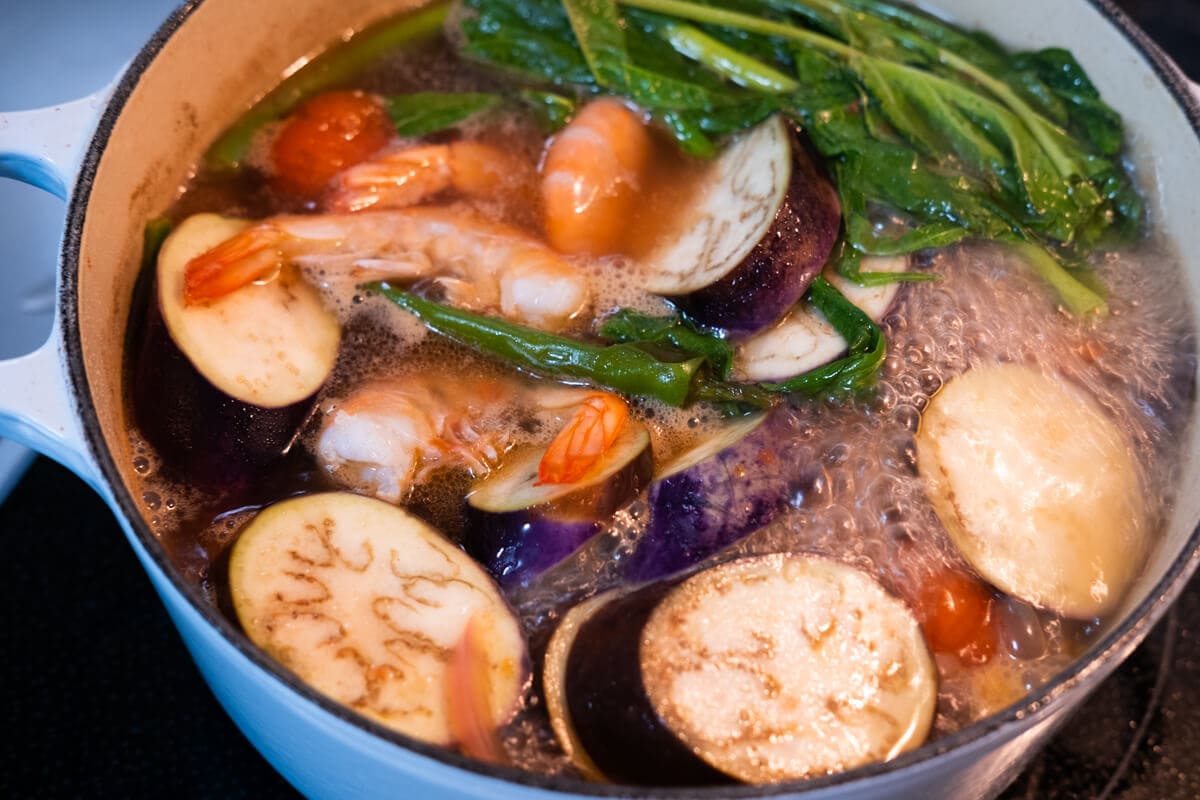
Step 4. Once the vegetables are done, add the prawns, which should take only around 3 minutes or so to cook. Finally, add the fish sauce and sugar and adjust the seasoning to your liking.
Helpful Tips For Home Cooks
- The dish is easily adaptable depending on what type of protein is on hand. You can use pork, beef, or prawns. The soup is also loaded with vegetables that are easily available in the Philippines like daikon, eggplants, snake beans, and water spinach.
- I use tamarind to create that signature sourness. As a fresh fruit, it is quite difficult to come by overseas, but tamarind pulp is readily available in Asian grocery stores. To make the base of the soup, tamarind pulp is soaked in hot water for a few minutes and then mashed, strained, and added to the pot.
- Tamarind paste is potent stuff, so begin with a small amount and gradually add more until you reach your desired level of sourness.
- Can’t find tamarind pulp or paste? Buy sinigang mix online or from your local Asian store. These complete seasoning packets come in various flavors like tamarind, taro, and miso.
- There’s really no substitute for fish sauce in a Pinoy recipe for shrimp sinigang. If you’re new to fish sauce, don’t worry because it won’t make the soup taste fishy or funky. Instead, it adds a complex savory layer you won’t get with salt alone.
- Sinigang is never complete without a bowl of steaming white rice and what we refer to as sawsawan, a dipping sauce made with fish sauce, calamansi, and a bit of chili.
- If you’re not serving this with rice—or just don’t want to use rice wash—go ahead and use regular water. The soup will still be delicious!
Frequently Asked Questions
Yes, you can use frozen shrimp for sinigang na hipon. No need to defrost! They cook fast, so toss them near the end to keep them plump and juicy.
Dilute your Filipino sour soup with hot water and add a touch of sugar to counter the tang. If you haven’t added the tamarind paste yet, do it bit by bit until it’s sour enough for you.
Yes, shrimp sinigang soup is so nourishing and perfect when you’re sick. The warm, tangy broth can help clear congestion and soothe your throat. It’s also hydrating and loaded with nutrients from the shrimp and vegetables.
This sinigang recipe has only 157 calories per serving.
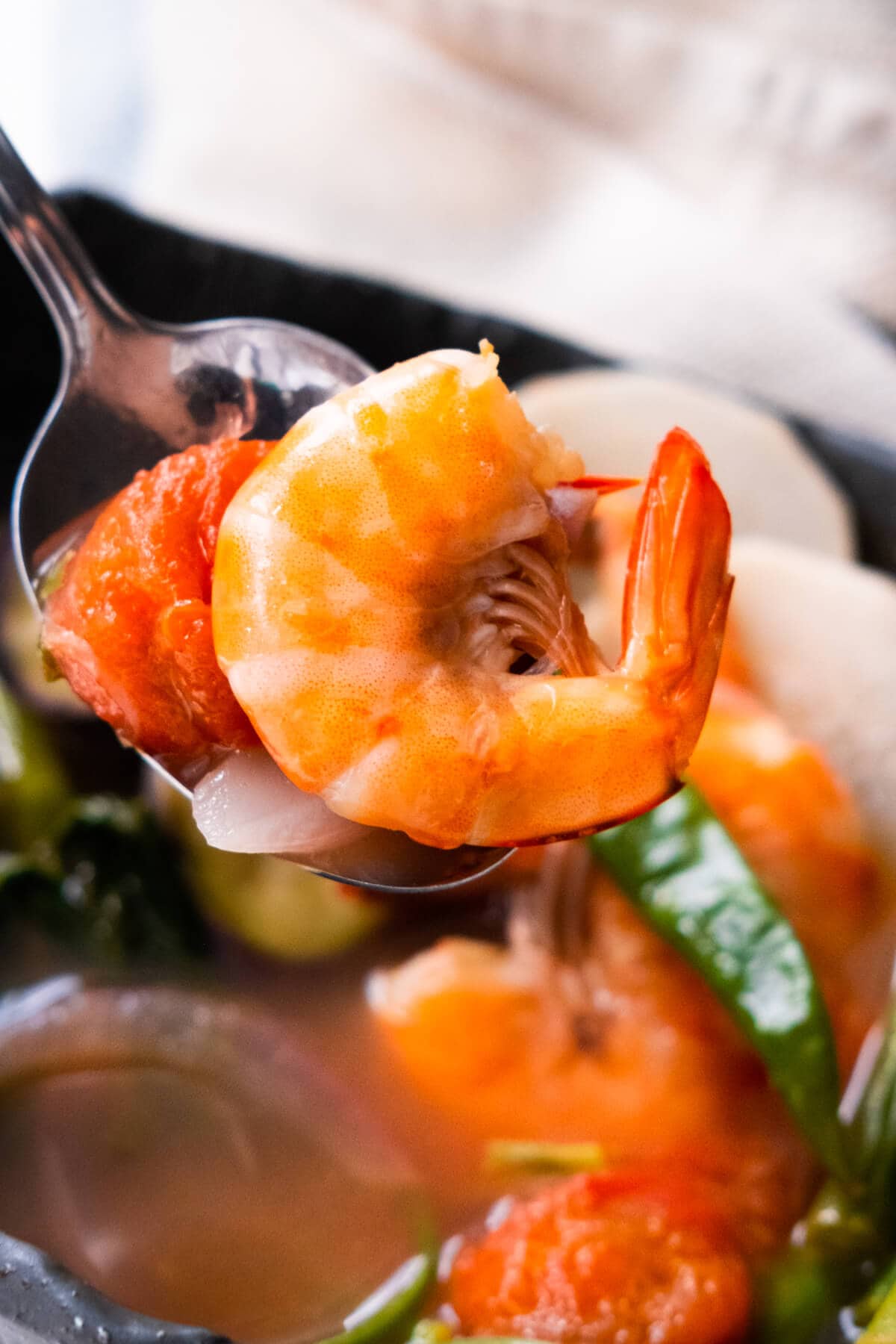
What To Serve With Sinigang Na Hipon
For an easy and wholesome Filipino meal, I recommend the following recipes:
I hope you enjoy this post as much as I do. If you try my recipe, please leave a comment and consider giving it a 5-star rating. For more easy and delicious recipes, explore my Recipe Index, and stay updated by subscribing to my newsletter and following me on Facebook, Pinterest, and Instagram for new updates.
Other Recipes You Might Like
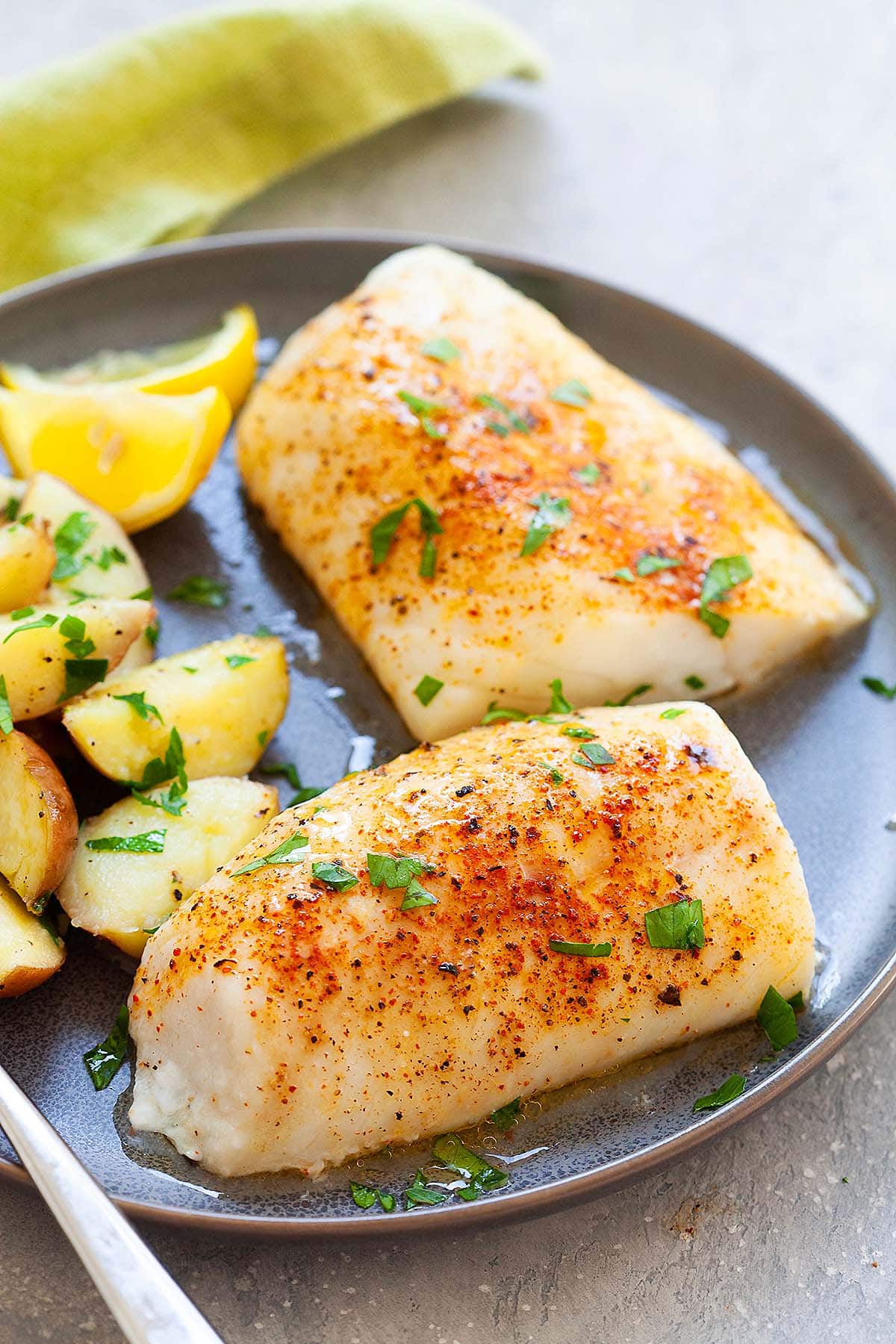
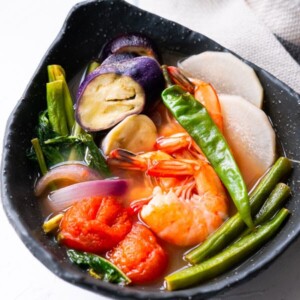
Shrimp Sinigang
Ingredients
- 1 tablespoon tamarind paste
- 24 pieces fresh prawns
- 2 tablespoons vegetable oil
- 1 red onion, sliced
- 2 large tomatoes, quartered (or 8 cherry tomatoes)
- 1 green chili
- 8 cups rice wash*
- 1/2 bunch snake beans, cut the size of 2 inches (5cm)
- 1 daikon, peeled and sliced
- 2 Japanese eggplants, sliced
- 1 bunch water spinach, also known as kang kong or morning glory
- ¼ cup fish sauce , or to taste
- 1 teaspoon sugar , or to taste
Instructions
- Heat the vegetable oil in a deep pot and sauté the red onion, tomatoes and green chili for two to three minutes.
- Add tamarind paste and the rice wash to the pot. Bring this to a boil and then turn down to a simmer to cook the vegetables.
For the vegetables
- Add them to the pot according to how long they take to cook. Add the vegetables that take longer to cook first. As an estimate, the snake beans will take around 7 minutes, the daikon and eggplant around 5 minutes and the water spinach around 3 minutes.
- Once the vegetables are done, add the prawns, which should take only around 3 minutes or so to cook.
- Finally, add the fish sauce and sugar and adjust the seasoning to your liking.
Notes
- The dish is easily adaptable depending on what type of protein is on hand. You can use pork, beef, or prawns.
- I use tamarind to create that signature sourness, and tamarind pulp is readily available in Asian grocery stores. To make the base of the soup, tamarind pulp is soaked in hot water for a few minutes and then mashed, strained, and added to the pot.
- Tamarind paste is potent stuff, so begin with a small amount and gradually add more until you reach your desired level of sourness.
- Can’t find tamarind pulp or paste? Buy sinigang mix online or from your local Asian store. These complete seasoning packets come in various flavors like tamarind, taro, and miso.
- There’s really no substitute for fish sauce in a Pinoy recipe for shrimp sinigang.
- Sinigang is never complete without a bowl of steaming white rice and what we refer to as sawsawan, a dipping sauce made with fish sauce, calamansi, and a bit of chili.
- If you’re not serving this with rice—or just don’t want to use rice wash—go ahead and use regular water.
Nutrition
Nutrition information is automatically calculated, so should only be used as an approximation.



